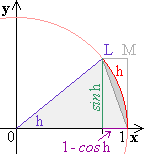| Oberstufe: Differential- und Integralrechnung |
| Oberstufenskript Differential- und Integralrechnung für Grund- und Leistungskurse von Jürgen Rohde |
13.7 Lineare Approximation der sin-Funktion
Vorübung: Vergleiche die Werte von cos x und 1 bzw. sin x und x für | x | < 0,1 .
Wegen
| ( 1 ) | sin ( x + h ) = sin x · cos h + cos x · sin h |
| und sin h |
| ( 2 ) | lx (h) = sin x + h · cos x |
| sin ' x = cos x |
| | R (h) | | = | sin ( x + h ) - lx (h) | = | sin x ( cos h - 1 ) + cos x ( sin h - h ) | |
| ( 3 ) |

Aus der Figur links liest man ab, da "Sehne < Bogen" :
| ( sin h )² + ( 1 - cos h )²
|
|
| ( 4 ) | 1 - cos h |
Weiter hat das Dreieck 01L den Inhalt ½ sin h ,
der Sektor 01L den Inhalt ½ h und
der Kreisabschnitt 1L1 (dunkler grau) ist der Fläche nach kleiner als das Dreieck LM1 .
Daraus folgt
![]()
| ( 5 ) | | sin h - h | | |
| sin h | · | 1 - cos h | | |
| 1 - cos h | | |
| 2x Inhalt des Kreisabschnitts |
2x Inhalt des Dreiecks LM1 |
beachte auch | sin h | |
||||
| | sin ( x + h ) - lx (h) | = | R (h) |
|
13.8 Die Ableitung weiterer Winkelfunktionen und ihrer Umkehrung
| Wegen | cos x = sin ( x + ½ |
||||||||||||
| folgt nach der Kettenregel |
|||||||||||||
| cos ' x = | cos ( x + ½ |
- sin x | (Kontrolle: Einheitskreis) | ||||||||||
| Mit Hilfe der Quotientenregel erhalten Sie über dem Definitionsbereich |
|||||||||||||
|
|||||||||||||
Die Winkelfunktionen sind nur abschnittsweise umkehrbar und haben beliebig viele Umkehrfunktionen, von denen man nach Vereinbarung eine auswählt. Sie sind in folgender Tabelle zusammengestellt.
| Funktion f | Definitions- breich f |
Umkehrfkt. |
Definitions- breich |
|||
| sin | [ - ½ |
arcsin | [ - 1 | 1 ] | x |
; | x | |
|
|---|---|---|---|---|---|---|
| cos | [ 0 | |
arccos | [ - 1 | 1 ] | x |
; | x | |
|
| tan | ] - ½ |
arctan | ] - |
x |
1 | |
| 1 + x² | ||||||
| cot | ] 0 | |
arccot | x |
1 | ||
| 1 + x² | ||||||
Beweise der Ableitungsregeln:
| Also | arcsin ' y = | 1 | = | 1 | = | 1 | oder wenn die Variable x heißt: | |
| sin ' x | cos x | |||||||
| arcsin ' x = | ; | x |
||||||
| Also gilt | arccos ' y = | 1 | = - | 1 | in ] -1 | + 1 [ |
| - sin x |
| arctan ' y = | 1 | = | 1 | = cos² x = | 1 | , denn cos² x = | 1 |
| tan ' x | 1 | 1 + y² | 1 + tan² | ||||
| cos² x | |||||||
| arccot ' y = - | 1 | |
| 1 + y² |
weiter zu
13.9 Stammfunktionen der Winkelfunktionen
![]()